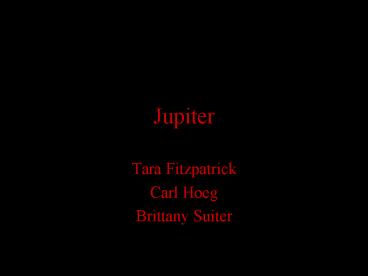Jupiter - PowerPoint PPT Presentation
1 / 19
Title:
Jupiter
Description:
Comet broke into 21 pieces before impact. Pieces fell onto Jupiter ... Comet debris spread into a haze that remained in Jupiter's atmosphere for several months ... – PowerPoint PPT presentation
Number of Views:125
Avg rating:3.0/5.0
Title: Jupiter
1
Jupiter
- Tara Fitzpatrick
- Carl Hoeg
- Brittany Suiter
2
General Characteristics
- Mass (kg) 1.900e27
- Mass (Earth 1) 3.1794e02
- Equatorial radius (km) 71,492
- Equatorial radius (Earth 1) 1.1209e01
- Mean density (gm/cm3) 1.33
- Mean distance from the Sun (km) 778,330,000
- Mean distance from the Sun (Earth 1) 5.2028
- Rotational period (days) 0.41354
- Orbital period (days) 4332.71
- Mean orbital velocity (km/sec) 13.07
- Orbital eccentricity 0.0483
- Tilt of axis (degrees) 3.13
- Orbital inclination (degrees) 1.308
- Equatorial surface gravity (m/sec2) 22.88
- Equatorial escape velocity (km/sec) 59.56
- Mean cloud temperature -121C
- Atmospheric pressure (bars) 0.7
- Atmospheric composition
- Hydrogen 90
3
- Jupiter is the fifth planet from the sun and is
the largest one in the solar system. - Jupiter, also known as Jove, was named after the
Greek God Zeus. - Its the fourth brightest object in the sky.
4
- If Jupiter were hollow, more than 1,000 Earths
could fit inside. - Auroral emissions, similar to Earths Northern
Lights, were observed in the polar regions.
5
Surface Features
- No Solid Surface
- Made of dense, colored clouds
- Light colored areas Zones
- Dark colored areas Belts
- Regions circle planet parallel to the equator
- Most noted feature is the Great Red Spot
6
Atmosphere
- Atmosphere is made up of layers
- 90 hydrogen
- 10 helium
- traces of water vapor, methane, and ammonia
7
Comet Impact
- Comet Shoemaker Levy 9 struck in July of 1994
- Comet broke into 21 pieces before impact
- Pieces fell onto Jupiter causing large
explosions - Compression heating
- Rapid expansion of atmospheric gasses.
- Comet debris spread into a haze that remained in
Jupiters atmosphere for several months
8
The Great Red Spot
- 1664 first seen
- About 3 Earths across
- Rotates completely every 6 Days
- Color
- Creation
9
(No Transcript)
10
Red Jr. Oval BA
11
Interior Structure
- Liquid Hydrogen layer
- Liquid Metallic Hydrogen Layer
- Core
12
Heat Emission
- Jupiter emits 1.688 time as much heat as it
receives. - Somehow Jupiter has or is generating Internal
Heat - Generate in the Decay of unstable isotopes
- Slow gravitational contraction enters the
atmosphere from the interior of the planet - Jupiter is an undersized star
- Leftover heat from the planets formation
13
Magnetic Field
- Convection and Rapid Rotation stirs up the liquid
metallic hydrogen in Jupiter - Drives Dynamo effect
- Generates Magnetic
- Field
- 10 times stronger
- than Earth
14
Magnetosphere
- Donut like rings coming from Jupiters Poles
- Similar to Earths Van Allen Belts
- Catch particles from Solar wind
- Particles are then stuck in the circular rings
- Levels of Radiation in Jupiters Magnetosphere is
over 4,000 times the lethal amount for a Human
15
Jupiters Auroras
- Around the poles of Jupiter Auroras can be seen
through UV observation - Auroras are electrical currents flowing down into
the atmosphere - Result of Solar wind and magnetic field
interacting
16
Jupiters Rings
- Jupiters Rings were a surprise discovery
- Observed by Voyager 1 in 1979
- Rings are a billion times less dense than
Saturns rings
17
Explorations
- Galileo discover Jupiters four large moons.
- Io
- Europa
- Ganymede
- Callisto
- They are known as the Galilean Moons and he
recorded their motions back and forth around
Jupiter.
18
Explorations Continued
- Jupiter was first visited by Pioneer 10 in 1973.
19
Explorations Continued
- The Rings of Jupiter were discovered in 1979 by
Voyager 1. - Ulysses has also been sent to take pictures of
Jupiter. - The space craft Galileo orbited Jupiter for 8
years. - Jupiter is regularly observed by the Hubble Space
Telescope.































